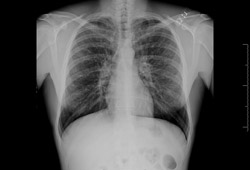Resumo
Definição
História e exame físico
Principais fatores diagnósticos
- presença de fatores de risco
- tosse
- produção de escarro
- estertores, chiado agudo ao inspirar e roncos
- dispneia
- febre
Outros fatores diagnósticos
- fadiga
- hemoptise
- rinossinusite
- perda de peso
- sibilância
- dor torácica pleurítica
- baqueteamento digital
Fatores de risco
- fibrose cística
- imunodeficiência do hospedeiro
- infecções prévias
- distúrbios congênitos dos brônquios (vias aéreas)
- discinesia ciliar primária
- deficiência de alfa 1-antitripsina
- doença do tecido conjuntivo
- doença inflamatória intestinal
- lesão por inalação ou aspiração
- obstrução brônquica focal
- mulheres brancas, altas, magras, com 60 anos de idade ou mais
- prematuridade
Investigações diagnósticas
Primeiras investigações a serem solicitadas
- tomografia computadorizada (TC) de alta resolução do tórax
- radiografia torácica
- Hemograma completo
- cultura de escarro e sensibilidade
- fenótipo e nível sérico de alfa 1-antitripsina
- imunoglobulinas séricas
- teste de cloreto no suor
- fator reumatoide
- teste alérgico cutâneo por puntura ou IgE específico para Aspergillus fumigatus
- anticorpo antivírus da imunodeficiência humana (anti-HIV) sérico
- óxido nítrico nasal
- testes de função pulmonar
Investigações a serem consideradas
- teste de discinesia ciliar primária (DCP)
- teste de mutação do gene da proteína reguladora da transmembrana da fibrose cística (CFTR)
- estudo de deglutição
- monitoramento do pH do esôfago
- teste de caminhada de 6 minutos
- teste de tuberculose
- broncoscopia diagnóstica com lavagem broncoalveolar
Algoritmo de tratamento
apresentação inicial
exacerbação aguda: doença subjacente leve a moderada
exacerbação aguda: doença subjacente grave ou ausência de resposta/resistente a antibióticos iniciais
3 ou mais exacerbações por ano, apesar da terapia de manutenção
primeiro ou novo isolamento de Pseudomonas aeruginosa na revisão ambulatorial
Colaboradores
Autores
Anne E. O'Donnell, MD
Professor of Medicine
Chief, Division of Pulmonary, Critical Care and Sleep Medicine
The Nehemiah and Naomi Cohen Chair in Pulmonary Disease Research
Georgetown University Medical Center
Washington
DC
Declarações
AEOD has received scientific consulting fees from the following companies: Bayer, Xellia, Horizon, Grifols, Insmed, and Electromed. AEOD is the Principal Investigator for trials sponsored by the following companies (research funding provided directly to Georgetown University): Bayer, Insmed, Aradigm, Parion, Zambon. AEOD has been a faculty member at the annual meetings of CHEST (American College of Chest Physicians), the American Thoracic Society, and the European Respiratory Society. AEOD is the author of a reference cited in this topic.
Agradecimentos
Dr Anne E. O'Donnell would like to gratefully acknowledge Dr Pamela J. McShane and Dr Sangeeta M. Bhorade, previous contributors to this topic.
Declarações
PJM and SMB declare that they have no competing interests.
Revisores
Philip W. Ind, BA (Cantab), MB BChir, MA (Cantab), FRCP
Emeritus Professor of Practice (Respiratory Medicine)
National Heart and Lung Institute
Imperial College London
London
UK
Declarações
PWI declares that he has no competing interests.
Meg Coleman, MBBS, BSc, MRCP
Respiratory Consultant
Honorary Senior Clinical Lecturer
Imperial College Hospitals NHS Trust and National Heart and Lung Institute
London
UK
Declarações
MC has received honoraria from Pfizer and Gilead for delivering educational sessions.
Amanda Messinger, MD, MS
Assistant Professor
Section of Pediatric Pulmonary and Sleep Medicine
Department of Pediatrics
Children's Hospital Colorado
University of Colorado Denver School of Medicine
Aurora
CO
Declarações
AM declares that she has no competing interests.
Ware Kuschner, MD
Associate Professor of Medicine
Stanford University
Stanford
Staff Physician
US Department of Veterans Affairs
Palo Alto Health Care System
Palo Alto
CA
Declarações
WK declares that he has no competing interests.
Créditos aos pareceristas
Os tópicos do BMJ Best Practice são constantemente atualizados, seguindo os desenvolvimentos das evidências e das diretrizes. Os pareceristas aqui listados revisaram o conteúdo pelo menos uma vez durante a história do tópico.
Declarações
As afiliações e declarações dos pareceristas referem--se ao momento da revisão.
Referências
Principais artigos
Chang AB, Fortescue R, Grimwood K, et al. European Respiratory Society guidelines for the management of children and adolescents with bronchiectasis. Eur Respir J. 2021 Aug;58(2):2002990.Texto completo Resumo
Hill AT, Sullivan AL, Chalmers JD, et al. British Thoracic Society guideline for bronchiectasis in adults. Thorax. 2019 Jan;74(suppl 1):1-69.Texto completo Resumo
O'Donnell AE. Bronchiectasis - a clinical review. N Engl J Med. 2022 Aug 11;387(6):533-45. Resumo
Hill AT, Barker AF, Bolser DC, et al. Treating cough due to non-CF and CF bronchiectasis with nonpharmacological airway clearance: CHEST Expert Panel Report. Chest. 2018 Apr;153(4):986-93.Texto completo Resumo
Polverino E, Goeminne PC, McDonnell MJ, et al. European Respiratory Society guidelines for the management of adult bronchiectasis. Eur Respir J. 2017 Sep 9;50(3):1700629.Texto completo Resumo
Smith D, Du Rand I, Addy CL, et al. British Thoracic Society guideline for the use of long-term macrolides in adults with respiratory disease. Thorax. 2020 May;75(5):370-404.Texto completo Resumo
Artigos de referência
Uma lista completa das fontes referenciadas neste tópico está disponível para os usuários com acesso total ao BMJ Best Practice.

Diagnósticos diferenciais
- Doença pulmonar obstrutiva crônica (DPOC)
- Asma
- Pneumonia
Mais Diagnósticos diferenciaisDiretrizes
- ACR appropriateness criteria: chronic dyspnea - noncardiovascular origin
- ACR appropriateness criteria: tracheobronchial disease
Mais DiretrizesFolhetos informativos para os pacientes
Bronquiectasia: o que é?
Bronquiectasia: quais são as opções de tratamento?
Mais Folhetos informativos para os pacientesVideos
Sibilos expiratórios
Estertores inspiratórios iniciais
Mais vídeosConectar-se ou assinar para acessar todo o BMJ Best Practice
O uso deste conteúdo está sujeito ao nosso aviso legal